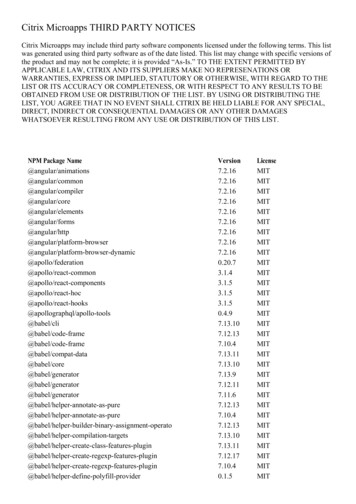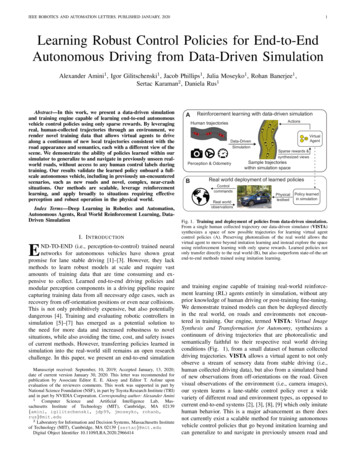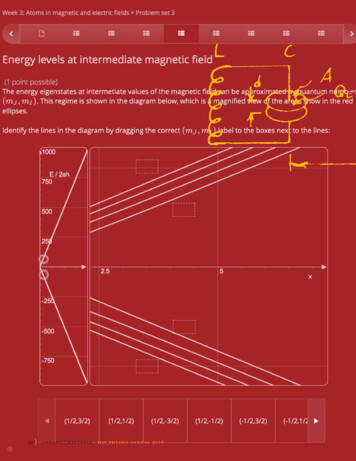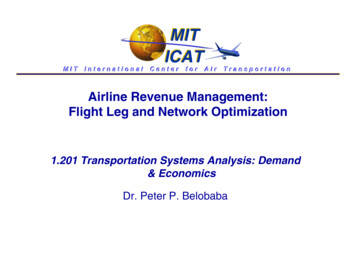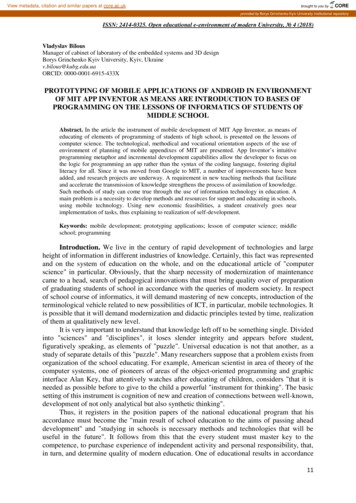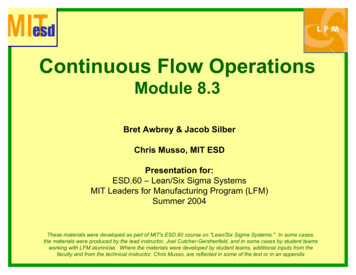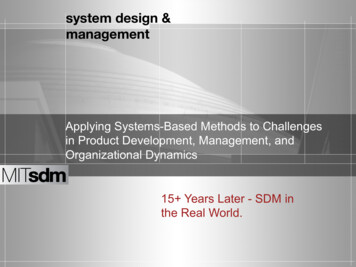
Transcription
system design &managementApplying Systems-Based Methods to Challengesin Product Development, Management, andOrganizational Dynamics15 Years Later - SDM inthe Real World.
Why Is This Topic Important?Standish Group 2015 Chaos s-20152
3
4
We are Running out of Time to Get it c653ef01b7c7c74037970b-popup5
A Bad Combination Large Project Success Rate of Less Than 20% Average Fortune 500 Life Expectancy approaching 15 Years"Would you like me to give you a formula for success? It's quite simple, really:Double your rate of failure. You are thinking of failure as the enemy ofsuccess. But it isn't at all. You can be discouraged by failure or you can learnfrom it, so go ahead and make mistakes. Make all you can. Becauseremember that's where you will find success." Thomas J. Watson6
My Goals for Today Present Relevant Foundational SDM Learnings that HelpedMe to Successfully Deliver Projects that Met or ExceededBusiness Expectations Motivate you to learn more about the Tools. Share my Experience and Lessons Learned.7
4 Foundational SDM Learnings that haveSurvived the Test of Time The Rework Cycle and a Balanced Process Disruptive Technology and The Innovator Dilemma Principles of Systems Architecture The Critical Chain – The Theory of Constraints8
The Rework CycleTypical Process:Work Being Done Work DoneProcess MaturityStaffProductivityQualityWork to Be DoneWork DoneWork Being DoneUndiscoveredReworkDiscoveryWorkTypically IgnoredStaffProductivityProcess Maturity9
Rework Cycle – Lessons Learned Undiscovered Rework is Real and can not be ignored Undiscovered Rework drives the 90% Done Syndrome Shorter Development Cycles speed the Rework DiscoveryCycle(s) – Agile SPRINTS Measuring, Analyzing and Root Cause Analysis on theUndiscovered Rework results in robust processimprovements Investing in Techniques to Discover Rework faster pays highdividends. The Discovered Defects provide hints into theUndiscovered Defects.10
A Balanced ProcessLEAN Inventory ManagementToyota 14 Management Principles1) Base Your Management Decisions on Long Term Philosophy2) Create Continuous Flow Process Flow to Bring Problems to theSurface3) Use “Pull” System to Avoid Over Production4) Level Out Workload5) Build a Culture of Stopping to Fix the Problem6) Standardized Tasks are the Foundation for Continuous Improvementand Employee Empowerment7) Use Visual Controls So No Problems are Hidden8) Use Only Reliable, Thoroughly Tested Technology9) Grow Leader Who Thoroughly Understand the Work, Live thePhilosophy, and Teach it To Others10) Develop Exceptional People and Teams Who Follow Your CompanyPhilosophy11) Respect Your Extended Network of Partners and Suppliers byChallenging Them and Helping Them to Improve12) Go and See for Yourself to Thoroughly Understand the Situation13) Make Decisions Slowly, Implement Decisions Rapidly14) Become a Learning Organization Through Relentless Reflection andContinuous Improvement11
Dev Op’s from and Inventory ntAdoptionMaxWIP (Labor) Investment LevelMinRequirementsDeployment12
A Balanced Process – Lessons Learned Success is all about Adoption – Design a Pull System –Market Test Functionality Frequently Measure Inventory Amount and Turnover (aging) betweeneach step. Inventory is Money, Labor is a Valuable Asset Build a Continuous Process System, avoid batching tasksbefore starting the next task – Make issues visible ASAP Staff the Process achieve a Balance Workflow.13
1St EditionPrinciples of System Architecture6th Edition14
Principles That I Retained after 15 Years Principle of Holism: Every system operates as part of one large system or severallarger systems, and each is composed of smaller systems Principle of Essential Complexity: Functionality Drives essential complexity.Describe the required functionality carefully, and then choose a concept that produces low complexity Principle of Decomposition: Decomposition is an active choice made by thearchitect. The decomposition affects how performance is measured, how organizations should be set upand the potential for supplier value capture Principle of Product Evolution: Systems will evolve or lose competitiveadvantage. When architecting, define the interfaces as the more stable parts of the system so that theelements can evolve.15
Disruptive Technology and TheDynamics of InnovationThis is one of the innovator’s dilemmas: Blindlyfollowing the maxim that good managers should keepclose to their customers can sometimes be a fatalmistake.”― Clayton M. Christensen, The Innovator's Dilemma: When NewTechnologies Cause Great Firms to Fail“Smart companies fail because they do everythingright. They cater to high-profit-margin customers andignore the low end of the market, where disruptiveinnovations emerge from.” Clayton Christensen“Those who study history and understand theory canmake better predictions.” James M. Utterback,16
The Dynamics of InnovationWhat do all of the below light bulbs have in ulbEdison screw (ES) is a standard socket for light bulbs inthe United States. It was developed by ThomasEdison and was licensed in 1909https://en.wikipedia.org/wiki/Edison screw17
The Dynamics of Innovation – Impacton System TransformationMy experience : Legacy Systemsare the “socket” that preventunconstrained SystemTransformation.Reasons: Legacy Systems are at the Center of the Universe. The Legacy System is the System of Record Company Wide Processes, Training andOrganizations have been optimized to align with theLegacy System18
The Dynamics of Innovation – LessonsLearned Move The Center of the Universe As Quickly asPossible Create the Desired Data Structure from the Start,manage the complexity during the transition Focus on Enterprise Wide Change ManagementConway’s Law: "Any organization that designs a system will inevitably produce a designwhose structure is a copy of the organization's communication structure.“ Melvin Conway19
Disruptive InnovationBecause the Utility of NewInnovations is less thanthe Legacy System: Management rejects the Investmentin technologies. The ROI does notmake sense The Business Opportunities appear tobe small with significant risk The functionality will get worse beforeit gets better Investment continues to flow intomaking the existing products ruptive-innovation20
Disruptive Innovation – Lessons Learnedwhen Making Technology Decisions Factor in the Expected the Slope of Changewhen Developing Technology Strategies Study Emerging Technologies to Understandthe Potential Impact the Technology can haveon your Business. Run Test, Learn how to Fail Quickly and FallForward21
The Critical Chain - The Theory of Constraints“I say an hour lost at a bottleneck is an hour outof the entire system. I say an hour saved at anon-bottleneck is worthless. Bottlenecksgovern both throughput and inventory.” EliyahuMoshe Goldratt22
Typical Gantt Chart MethodTask 1BufferTask 2BufferTask 3Buffer There is Uncertainty in All Task Estimations Tasks are Estimated at a 90% Certainty of Completion The Process Encourages Unproductive Behaviors23
Unproductive Behaviors Over Estimation The Student Syndrome Multitasking Tasks Never Finish Early24
Over Estimation – Buffer ome/25
The Student Syndrome – Buffer t-finishing-projectson-time/26
Multitasking – Buffer Out Switching Cost: According to theAmerican Psychological Association, shiftingbetween tasks can cost you up to 40 percentproductive time. Less Effective :A study by theUniversity of Utah found that talking on evena hands-free mobile phone while driving cancause impairment similar to driving with a .08blood-alcohol level Slow Your Brain Down: A studyby Stanford researchers found the brains ofpeople who multitask work less efficientlyeven when they’re not multitasking.27
Critical Chain Gantt ChartTask 1Task 2Task 3Project Buffer Estimate Tasks at 50% Certainty Level (1/2 of 90%Estimate). To finish on time, the task needs to bestarted on time. Identify the Critical Path – One Day lost on the CriticalPath One Day Lost to the Project. No Multitasking onThe Critical Chain Consolidate Individual Task Buffer into Project Buffer.Removing the Task Buffers enable Tasks to Finish Early28
Summary: Tools That Increase theProbability of Project Success. The Rework Cycle and a Balanced Process Disruptive Technology and The Innovator Dilemma Principles of Systems Architecture The Critical Chain – The Theory of Constraints29
Thank You30
Contact ronpepincio31
system design & management Applying Systems-Based Methods to Challenges in Product Development, Management, and Organizational Dynamics 15 Years Later -SDM in
